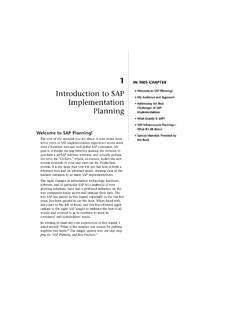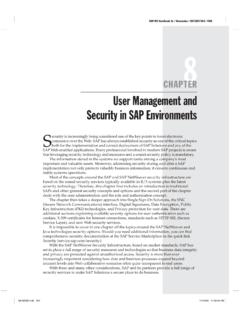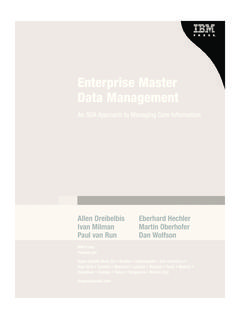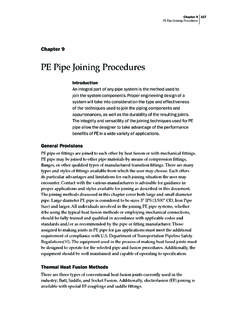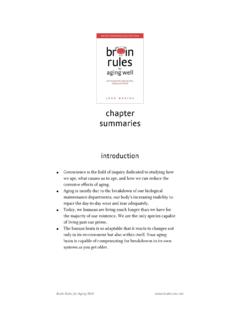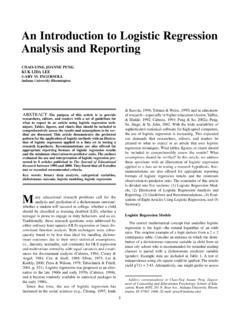Transcription of CHAPTER SAP ERP Integration Overview with Other Systems
1 CompRef8 / SAP Basis Administration Handbook, NetWeaver Edition / Mereddy / 348-7. CHAPTER . 4. SAP ERP Integration Overview with Other Systems S. o far in the first three chapters of this book we have studied an Overview of SAP. business suite applications and the NetWeaver Application Server ABAP and Java technology foundation that it runs on. In this CHAPTER we will study the central role the SAP ERP system has in an organization and its network Integration into the organization's enterprise infrastructure, as well as to the external Systems outside the organization and the SAP support infrastructure. This CHAPTER covers various communication and Integration technologies that bind different SAP ABAP and Java-based applications, along with the third-party enterprise solutions, external vendors, and SAP support organization into an enterprise-wide SAP solution adding value and driving the business needs of an organization.
2 This CHAPTER is also intended to give an Overview to enterprise architects as to how a SAP. solution would fit into an enterprise-wide architecture. Figure 4-1 illustrates the Integration scenarios that could come into play with the implementation and operations of a SAP ERP system for a hypothetical SAP customer. The remaining sections of this CHAPTER will use this hypothetical scenario to explain the common Integration scenario groupings and the underlying communication protocol and standards used by SAP. Basic Communication in SAP Business Solutions SAP business applications use the following protocols and standards for communication and data transfer between different Systems . One of the following basic network and communication standards is at the heart of the different Integration scenarios with the SAP.
3 ERP system . Let us look into the details of each of the following protocols and standards. TCP/IP. In SAP business applications, network communication is with the Transmission Control Protocol/Internet Protocol (TCP/IP) standards. During the system build phase, the required IP address is assigned to the host and necessary configuration is performed where a particular SAP business solution is planned to be installed. 49. 49 9/27/11 2:00:10 PM. CompRef8 / SAP Basis Administration Handbook, NetWeaver Edition / Mereddy / 348-7. 50 Part I: SAP NetWeaver introduction and Architecture Vendor Firewall SAP Firewall WAN SAProuter SAP Support External Vendor EDI system Vendor LAN SAP LAN. Customer Firewall Customer LAN EDI SAProuter system SAP SAP CRM Taxware D&B Autosys In-house Central SAP. Admin & Expert Monitoring SAP SRM Tivoli Enterprise Wide Operations Team SAP SCM Open Solution Manager view Level 1.
4 SAP PLM SAP ERP SAP. FileNet Support Mercury SAP BI. ITG. CA. SLD SAP Topcall uPerform Microsoft Helpdesk Portal OutLook CUA. Service Legacy SAP PI. Desk Interfaces Figure 4-1 ERP Integration scenarios Network Ports SAP business applications listen at clearly defined port numbers for incoming network connections. Table 4-1 lists the most important port numbers and the naming conventions and rules used for defining them for ABAP-based SAP applications. Service Default TCP Service Name Default Port # Range Dispatcher sapdp## where ## is the system number of the instance 3200 3200 3299. Message sapms<SID> where SID = system Identifier 3600 Free Server Gateway sapgw## where ## is the system number of the instance 3300 3300 3399. ICM HTTP 80## where ## = system number of the instance 8000 Free ICM HTTPS 443## where ## = system number of the instance Not Active Free ICM SMTP 25 Not Active 25.
5 Table 4-1 Network Ports in SAP ABAP Applications 50 9/27/11 2:00:10 PM. CompRef8 / SAP Basis Administration Handbook, NetWeaver Edition / Mereddy / 348-7. CHAPTER 4: SAP ERP Integration Overview with Other Systems 51. Service Default TCP Service Name Default Port # Range HTTP 5##00 where ## is the system number of 50000 50000 59900. the instance PART I. HTTP over SSL 5##01 where ## is the system number of 50001 50001 59901. the instance Telnet 5##08 where ## is the system number of 50008 50008 59908. the instance Table 4-2 Network Ports in SAP Java Applications SAP Java based applications use a different set of network ports. Table 4-2 lists the most important ports and rules for using the SAP Java based applications. In UNIX operating Systems , the services file maps port numbers to the named services.
6 This entry gets there during the time of the SAP installation of a given business solution. The services file location in a UNIX operating system is /etc/services. If, for any reason, the service file entry is missing, then the communication between the SAP applications will be lost and can be restored by adding an entry manually. Usually it requires a root user permission to make any changes to the etc/services file. RFC. Remote Function Call (RFC) is SAP's communication interface. RFC communication between SAP business solutions involves an RFC client and an RFC server. The RFC server provides function modules. RFC clients call one of the function modules, pass on the data, and get a reply (value) back from the RFC server. Setting Up an RFC Connection Transaction code SM59 is used to create new RFC connections or to alter an existing connection.
7 Several types of RFC connections can be set up in SAP Systems using SM59. transaction code. RFC connection types 3 (connects to another ABAP system ) and T . (TCP/IP Connection) are most often used. The following procedure is used to set up an RFC connection type 3 in SAP Systems . Use transaction code SM59 in the SAPGUI command line (see Figure 4-2). Select the connection type ABAP Connections, and click the Create icon. This will open the screen shown in Figure 4-3. Enter the following fields to complete the RFC destination configuration: RFC Destination Name of the RFC destination of the target ABAP system . Description Enter a text description. Target Host Enter the hostname or the IP address of the target ABAP system . system Number Enter the target ABAP system number. 51 9/27/11 2:00:10 PM.
8 CompRef8 / SAP Basis Administration Handbook, NetWeaver Edition / Mereddy / 348-7. 52 Part I: SAP NetWeaver introduction and Architecture Copyright by SAP AG. Figure 4-2 Initial RFC creation screen Click the Logon & Security tab, and enter the logon information (Client, User, and Password). After this, save your connection entries by clicking the Save button, as in Figure 4-4. If you receive any message window saying the user can log in to the remote system , just click OK and continue. Your connection entries will be saved. The next step is to test if our RFC connection is working properly. Click the Connection Test button at the top of the screen. You will see the screen shown in Figure 4-5 if all of your connection entries are correct. This is a basic connection test. This does not test the authorizations of the user who initiated the connection.
9 In order to test if this user has the authorizations to initiate an RFC connection and successfully log in to the target system , go back to your RFC connection parameters screen and use the menu option Utilities | Test | Authorization Test. This test should be successful as well before you can proceed with your work in the target ABAP system or use this connection for noninteractive login by application. You can use the similar procedure to create RFC connections to different ABAP Systems in your SAP. 52 9/27/11 2:00:10 PM. CompRef8 / SAP Basis Administration Handbook, NetWeaver Edition / Mereddy / 348-7. CHAPTER 4: SAP ERP Integration Overview with Other Systems 53. PART I. Copyright by SAP AG. Figure 4-3 RFC connection entries system landscape. Please note that a successful authorization test is mandatory, as this test executes a user login along with password verification and authorization test in the target RFC-connected system .
10 A successful authorization test ensures that the RFC connection is completely ready for use in an application. Several Other RFC connection types are used to integrate the SAP system landscape. The RFC connection type T refers to starting an external program using TCP/IP. One example of such need in a SAP system landscape Integration scenario is within the SAP Process Integration application. In this scenario the Process Integration (PI) ABAP components integrate with the SAP PI Java component using this connection type. The SAP PI ABAP system integrates with the SAP Java based PI component referred to as the system Landscape Directory (SLD) using an RFC connection called SAPSLDAPI. Figure 4-6 shows the details that have to be entered in setting up a TCP/IP RFC connection type. In this type of connection, a registered server program ID is entered in the RFC.
